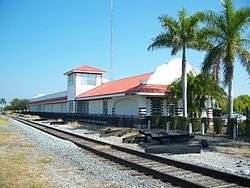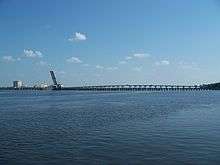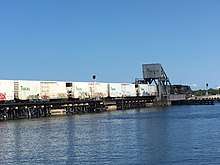Tampa Southern Railroad
 Former Bradenton passenger depot, which is now a medical clinic | |
| Reporting mark | TAS |
|---|---|
| Dates of operation | 1917–1967 |
| Successor |
Atlantic Coast Line Railroad Seaboard Coast Line Railroad CSX Transportation |
| Track gauge | 4 ft 8 1⁄2 in (1,435 mm) standard gauge |
The Tampa Southern Railroad was a subsidiary of the Atlantic Coast Line Railroad originally running from Uceta Yard in Tampa south to Palmetto, Bradenton, and Sarasota with a later extension southeast to Fort Ogden in the Peace River valley built shortly after. It was one of many rail lines built during the Florida land boom of the 1920s. Most of the remaining trackage (between Tampa and Bradenton) now serves as CSX Transportation's Palmetto Subdivision.[1][2] Another short portion just east of Sarasota also remains that now serves as Seminole Gulf Railway's Matoaka branch.
History

The Tampa Southern Railroad was first incorporated in 1917 as a subsidiary of the Atlantic Coast Line Railroad. It principally competed with the Seaboard Air Line Railroad's parallel route (largely built by their Florida West Shore Railway subsidiary) that ran from Durant to Venice which was completed earlier in 1911. The Tampa Southern's tracks were completed to Sarasota by May 1924, and the first passenger train arrived in Sarasota in December of that year.[3]
The Tampa Southern began at the Atlantic Coast Line Railroad's Uceta Yard in Tampa and ran south, paralleling the east shore of Tampa Bay. Just northeast of Palmetto, a loop was constructed through Ellenton to serve agricultural growers. Known as the "Ellenton Belt Line", the now abandoned loop branched off the main line near Rubonia and ran in a roughly rectangular trajectory through Ellenton before returning to the main line in Palmetto. A short spur to Terra Ceia, which is now abandoned, also existed near this area.[4]
South of Palmetto, the tracks crossed the Manatee River on a bascule bridge into Bradenton, with Bradenton's passenger depot (which still stands today and serves as a medical clinic[5]) built just south of the bridge. The tracks then turned southeast for a short distance and crossed the Seaboard line before turning south again and into Sarasota near Fruitville. A spur to the Payne Terminal at Hog Creek existed just north of the Sarasota passenger depot (which was located at Main Street and School Avenue).[6]
Extension to Fort Ogden
By 1927, the line extended as far south as Fort Ogden in Desoto County. From the Sarasota depot, the line turned east through Fruitville, briefly running directly beside the Seaboard line before its southerly turn towards Venice. Once out of Sarasota, the line turned southeast passing through Utopia before crossing the Myakka River and continuing through Honore and Sidell. It crossed the Charlotte Harbor and Northern Railway and the Peace River just before coming to a point just south of Fort Ogden, where it merged with the Atlantic Coast Line Railroad's line from Lakeland to Fort Myers and Naples. Today, Desoto County Road 761 runs along the former right of way from the Peace River to Fort Ogden. In addition to serving freight customers along the line, the Fort Ogden extension frequently served as a shortcut for passenger trains traveling from Tampa to Fort Myers and Naples. Most of the Fort Ogden extension was removed by 1949 and the line was truncated at Belspur (just east of Fruitville).[7]
Mergers
In 1967, the Atlantic Coast Line Railroad merged with the Seaboard Air Line to form the Seaboard Coast Line Railroad. Connections were established between the Tampa Southern and the Seaboard route in a number of locations. The merger also resulted in the removal of the Seaboard Air Line's swing bridge over the Manatee River (which was located a short distance upstream of both the Tampa Southern's bascule bridge and the Desoto Bridge). The city of Bradenton unsuccessfully attempted to have the Seaboard Coast Line remove the Tampa Southern bridge instead since it went right through downtown Bradenton's waterfront.[8]
The Tampa Southern route then became the Seaboard Coast Line's main route for all trains between Palmetto and Tampa including Tropicana's Juice Train (which was originally operated by the Seaboard Air Line), since it provided a more direct route to the Tampa yards. The Seaboard Coast Line would later merge with the Chessie System in 1980 which created CSX Transportation. The Seaboard's original route between Durant and Willow was removed by CSX in 1986, leaving the Tampa Southern route as the only thru route.[9]
Current operations
Palmetto Subdivision | |||||||||||||||||||||||||||||||||||||||||||||||||||||||||||||||||||||||||||||||||||||||||||||||||||||||||||||||||||||||||||||||||||||||||||||||||||||||||||||||||||||||||||||||||||||||||||||||||||||||||||||||||||||||||||||||||||||||||||||||||||||||||||||||||||||||||||||||||||||||||||||||||||||||||||||||||||||||||||||||||||
|---|---|---|---|---|---|---|---|---|---|---|---|---|---|---|---|---|---|---|---|---|---|---|---|---|---|---|---|---|---|---|---|---|---|---|---|---|---|---|---|---|---|---|---|---|---|---|---|---|---|---|---|---|---|---|---|---|---|---|---|---|---|---|---|---|---|---|---|---|---|---|---|---|---|---|---|---|---|---|---|---|---|---|---|---|---|---|---|---|---|---|---|---|---|---|---|---|---|---|---|---|---|---|---|---|---|---|---|---|---|---|---|---|---|---|---|---|---|---|---|---|---|---|---|---|---|---|---|---|---|---|---|---|---|---|---|---|---|---|---|---|---|---|---|---|---|---|---|---|---|---|---|---|---|---|---|---|---|---|---|---|---|---|---|---|---|---|---|---|---|---|---|---|---|---|---|---|---|---|---|---|---|---|---|---|---|---|---|---|---|---|---|---|---|---|---|---|---|---|---|---|---|---|---|---|---|---|---|---|---|---|---|---|---|---|---|---|---|---|---|---|---|---|---|---|---|---|---|---|---|---|---|---|---|---|---|---|---|---|---|---|---|---|---|---|---|---|---|---|---|---|---|---|---|---|---|---|---|---|---|---|---|---|---|---|---|---|---|---|---|---|---|---|---|---|---|---|---|---|---|---|---|---|---|---|---|---|---|---|---|---|---|---|---|---|---|---|---|---|---|---|---|---|---|---|---|---|---|---|---|---|---|---|---|---|---|---|---|---|---|---|---|---|---|
| |||||||||||||||||||||||||||||||||||||||||||||||||||||||||||||||||||||||||||||||||||||||||||||||||||||||||||||||||||||||||||||||||||||||||||||||||||||||||||||||||||||||||||||||||||||||||||||||||||||||||||||||||||||||||||||||||||||||||||||||||||||||||||||||||||||||||||||||||||||||||||||||||||||||||||||||||||||||||||||||||||
| Note: Line with AZA mileposts is the Tampa Southern route. SW mileposts are along the former Seaboard Air Line route. | |||||||||||||||||||||||||||||||||||||||||||||||||||||||||||||||||||||||||||||||||||||||||||||||||||||||||||||||||||||||||||||||||||||||||||||||||||||||||||||||||||||||||||||||||||||||||||||||||||||||||||||||||||||||||||||||||||||||||||||||||||||||||||||||||||||||||||||||||||||||||||||||||||||||||||||||||||||||||||||||||||

Most of the remaining Tampa Southern Railroad trackage from Tampa to Bradenton comprises CSX's Palmetto Subdivision, with the northernmost five miles being part of the Tampa Terminal Subdivision. A control point of the line just north of State Road 60 is still referred to by CSX as "TS," a reference to the Tampa Southern.[2]
The line notably serves Port Manatee in northern Manatee County. It also serves the Tropicana Juice Plant in Bradenton, with Tropicana's Juice Train continuing to be the most consistent service on the line today.
The main Tampa Southern Railroad tracks end near the Tropicana Plant in Bradenton. Although, the Palmetto Subdivision continues south from here a short distance to Oneco along the former Seaboard line. In Oneco, it connects with Seminole Gulf Railway, who operates the remaining Seaboard tracks south through Sarasota. Seminole Gulf also operates a discontinuous segment of the Tampa Southern Railroad just east of Downtown Sarasota. It is part of their branch from Fruitville to Matoaka. US 301 now runs on the roughly five-mile abandoned segment between the Seminole Gulf segment of the Tampa Southern and the CSX main segment.
The line's milepost numbers on both segments have remained consistent since the Atlantic Coast Line era, though they have been given an AZA prefix.
Parrish Spur
The Parrish Spur, which was originally part of the Seaboard line, is mostly owned by Florida Power and Light today, but CSX continues to rarely operate over the line to serve FPL's power plant in Willow. The Florida Railroad Museum operates excursion trains on this line between Parrish and Willow, although the segment from Willow to Durant was pulled up in the mid 1980s.
See also
References
- ↑ http://wiki.radioreference.com/index.php/PT-Palmetto_Sub CSX Palmetto Sub
- 1 2 CSX Jacksonville Division Timetable
- ↑ "Atlantic Coast Line Railroad Depot". Sarasota County (official website). Retrieved 18 October 2015.
- ↑ Turner, Gregg M. (2003). A Short History of Florida Railroads. Charleston, SC: Arcadia Publishing. ISBN 978-0-7385-2421-4.
- ↑ "Train Depot in Bradenton". Charlotte County, Florida: History Collections Online. Retrieved 14 August 2013.
- ↑ "Atlantic Coast Line Railroad Depot". Sarasota History Alive!. Retrieved 14 August 2013.
- ↑ Turner, Gregg M. (December 1, 1999). Railroads of Southwest Florida. Images of America. Arcadia Publishing.
- ↑ "Seaboard and Bradenton Have Dispute Over Manatee River Trestles". Sarasota Herald Tribune. 12 June 1969. Retrieved 22 December 2013.
- ↑ "The Sarasota Subdivision". Abandoned Rails. Retrieved 22 December 2013.